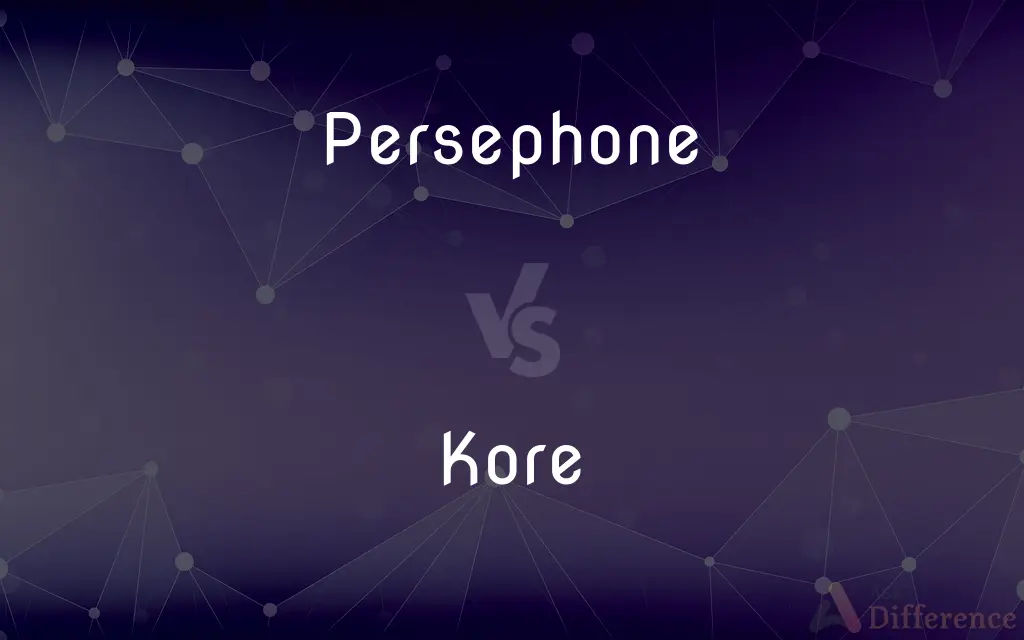Persephone vs. Kore — What's the Difference?
By Tayyaba Rehman & Maham Liaqat — Updated on April 8, 2024
Persephone is often associated with the underworld and its queen, while Kore signifies her aspect as a maiden goddess of spring.

Difference Between Persephone and Kore
Table of Contents
ADVERTISEMENT
Key Differences
Persephone is best known as the queen of the underworld in Greek mythology, a role she assumes upon her marriage to Hades. This aspect emphasizes themes of death, rebirth, and the seasonal cycle. On the other hand, Kore represents Persephone's identity as the youthful daughter of Demeter, embodying innocence, growth, and the vital force of nature's renewal.
While Persephone's narrative is heavily tied to the myth of her abduction by Hades, which leads to her dual life between the underworld and the earth, Kore's story highlights her role in agriculture and the fertility of the earth before her abduction. This duality marks the seasonal change from winter to spring and vice versa.
Persephone's dual identity reflects ancient Greek beliefs about the cyclical nature of life and death, as well as the interconnectedness of joy and sorrow. Whereas Kore, in her aspect as a maiden, symbolizes the hope and purity associated with the spring and the reawakening of the earth.
In rituals and worship, Persephone is venerated as a deity of the underworld with rites that emphasize mysticism and the afterlife. In contrast, Kore is celebrated through festivals like the Eleusinian Mysteries, which focus on agricultural fertility and the renewal of life.
The name "Persephone" is often used in literature and art to evoke themes of loss, return, and the balance between light and dark. Kore, however, is invoked to represent youth, beginnings, and the promise of new growth.
ADVERTISEMENT
Comparison Chart
Role
Queen of the Underworld
Maiden Goddess of Spring
Symbolism
Death, rebirth, seasonal cycle
Innocence, growth, nature's renewal
Myth
Abduction by Hades, dual life
Pre-abduction, associated with fertility
Themes
Cyclical nature of life, interconnectedness of joy and sorrow
Hope, purity, reawakening of earth
Worship and Rituals
Mysticism, afterlife
Agricultural fertility, life renewal
Compare with Definitions
Persephone
Queen of the Underworld in Greek mythology.
In the myth, Persephone is abducted by Hades to be his wife.
Kore
Maiden aspect of Persephone.
As Kore, she is depicted as a young and vibrant goddess.
Persephone
Represents the cycle of life and death.
Persephone's return to the surface symbolizes spring's arrival.
Kore
Embodies spring and growth.
Kore's presence heralds the renewal of nature.
Persephone
Associated with the Eleusinian Mysteries.
Initiates into the mysteries revered Persephone's dual role.
Kore
Represents purity and innocence.
Kore, before her abduction, lived a life free of the underworld's shadows.
Persephone
Daughter of Demeter.
Demeter's grief over Persephone's abduction causes winter.
Kore
Involved in the Eleusinian Mysteries as a figure of renewal.
Celebrants of the mysteries honored Kore for her part in the cycle of life.
Persephone
Symbol of rebirth.
Persephone is often depicted with pomegranate seeds, signifying her rebirth.
Kore
Central to agricultural myths.
The return of Kore is celebrated in festivals marking the end of winter.
Persephone
In Greek mythology, Persephone ( pər-SEF-ə-nee; Greek: Περσεφόνη, romanized: Persephónē), also called Kore or Kora ( KOR-ee; Greek: Κόρη, romanized: Kórē, lit. 'the maiden'), is the daughter of Zeus and Demeter. She became the queen of the underworld after her abduction by Hades, the god of the underworld, with the approval of her father, Zeus.
Kore
A sculpture representing a standing young woman clothed in long robes, especially one produced in Greece before the fifth century BC.
Persephone
The daughter of Demeter and Zeus who was abducted by Hades but rescued by her mother and thereafter spent six months of the year on earth and six months in the underworld.
Kore
An Ancient Greek statue of a woman, portrayed standing, usually clothed, painted in bright colours and having an elaborate hairstyle.
Persephone
(Greek mythology) daughter of Zeus and Demeter; made queen of the underworld by Pluto in ancient mythology; identified with Roman Proserpina
Kore
(Greek mythology) daughter of Zeus and Demeter; made queen of the underworld by Pluto in ancient mythology; identified with Roman Proserpina
Common Curiosities
What does Kore represent?
Kore represents the maiden aspect of Persephone, symbolizing youth, growth, and the renewal of nature.
What myth is associated with Persephone?
The myth of Persephone centers on her abduction by Hades and her role as the queen of the underworld and as a symbol of the seasonal cycle.
What is the significance of Persephone in Greek mythology?
Persephone's significance lies in her embodiment of the cycle of life and death, reflecting the ancient Greeks' understanding of the natural world.
Who is Persephone?
Persephone is the queen of the underworld and a goddess of spring in Greek mythology.
Why does Demeter mourn Persephone's absence?
Demeter mourns Persephone's absence because her daughter's time in the underworld coincides with the barren season, reflecting her sorrow in the winter landscape.
Can Persephone leave the underworld?
Yes, according to myth, Persephone divides her time between the underworld and the earth, symbolizing the seasonal change.
How are Persephone and Kore related?
Kore is an aspect of Persephone, focusing on her youthful and innocent qualities before her abduction.
How is Kore worshipped?
Kore is worshipped as a goddess of agriculture and fertility, often in rituals celebrating the renewal of life and the coming of spring.
Is Kore a separate deity from Persephone?
Kore is not a separate deity but rather an aspect of Persephone that highlights her youthful and maiden qualities.
What are the Eleusinian Mysteries?
The Eleusinian Mysteries were ancient Greek rites of initiation centered on the myth of Persephone's abduction and return, celebrating themes of death and rebirth.
What lesson can be learned from the myth of Persephone and Kore?
The myth teaches about the balance of life and death, the importance of seasons, and the idea that loss can lead to renewal and growth.
What does Persephone's abduction symbolize?
Persephone's abduction symbolizes the cycle of the seasons, the balance between life and death, and the eternal renewal of nature.
How does the story of Persephone and Kore impact ancient and modern cultures?
The story influences cultures by embodying the cycles of nature and life, inspiring rituals, art, literature, and understanding of life’s cyclical nature and renewal.
What symbol is often associated with Persephone?
The pomegranate seed is a symbol often associated with Persephone, representing her marriage to Hades and her role in the seasonal cycle.
How does Kore’s aspect differ from Persephone’s queen of the underworld role?
Kore's aspect emphasizes innocence and the vitality of spring, whereas Persephone’s role as queen of the underworld is associated with death and rebirth.
Share Your Discovery

Previous Comparison
Hearty vs. Heartly
Next Comparison
Rescind vs. RetractAuthor Spotlight
Written by
Tayyaba RehmanTayyaba Rehman is a distinguished writer, currently serving as a primary contributor to askdifference.com. As a researcher in semantics and etymology, Tayyaba's passion for the complexity of languages and their distinctions has found a perfect home on the platform. Tayyaba delves into the intricacies of language, distinguishing between commonly confused words and phrases, thereby providing clarity for readers worldwide.
Co-written by
Maham Liaqat













































